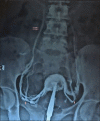Hysterosalpingography Observations in Female Genital Tuberculosis with Infertility
- PMID: 37033134
- PMCID: PMC10077740
- DOI: 10.4103/jhrs.jhrs_111_22
Hysterosalpingography Observations in Female Genital Tuberculosis with Infertility
Abstract
Background: Hysterosalpingography (HSG) is radiographic evaluation of uterine cavity and tubal patency.
Aims: The aim of this study was to evaluate the safety and utilisation of HSG in female genital tuberculosis (FGTB) with infertility.
Settings and design: The study was conducted in a tertiary referral centre of North India.
Materials and methods: It was a prospective study on 87 cases of FGTB with infertility. Diagnosis of FGTB was made by composite reference standard using the presence of acid-fast bacilli on microscopy/culture or positive GeneXpert, positive polymerase chain reaction or epithelioid granuloma on endometrial biopsy or definitive or probable findings on laparoscopy or hysteroscopy.
Statistical analysis used: Suitable statistical methods were used with STATA software version 12.0.
Results: HSG findings were normal in 49 (56.32%) cases. There were filling defects in 14 (16.09%), short and shrunken cavity in 4 (4.49%), intrauterine synechiae in 14 (16.09%), T-shaped cavity in 3 (3.44%) and deformed uterine cavity in 5 (5.74%) cases. Fallopian tube findings were hydrosalpinx in 12 (13.79%) and 11 (12.64%) cases, beading of tube in 4 (4.59%) and 2 (2.29%) cases, pipestem appearance in 2 (2.29%) cases each and Maltese cross appearance in 3 (3.44%) and 2 (2.29%) cases, respectively. Tubal blockage was seen in 69 (79.31%) and 67 (77.01%) cases being cornual block in 28 (32.18%) and 26 (29.88%) cases, mid-tubal block in 16 (18.39%) and 15 (17.24%) cases, multiple blocks in 10 (11.49%) and 12 (13.79%) cases and fimbrial block in 15 (17.24%) and 14 (16.09%) cases. None of the cases had flare-up of the disease after HSG in the current study.
Conclusion: HSG is a useful modality in FGTB with infertility.
Keywords: Extrapulmonary tuberculosis; female genital tuberculosis; hysterosalpingography; infertility.
Copyright: © 2022 Journal of Human Reproductive Sciences.
Conflict of interest statement
There are no conflicts of interest.
Figures








References
-
- Evers JL. Female subfertility. Lancet. 2002;360:151–9. - PubMed
-
- Reis MM, Soares SR, Cancado ML, Camargos AF. Hysterosalpingo contrast sonography (HyCoSy) with SH U 454 (Echovist) for the assessment of tubal patency. Hum Reprod. 1998;13:3049–52. - PubMed
-
- Lim CP, Hasafa Z, Bhattacharya S, Maheshwari A. Should a hysterosalpingogram be a first-line investigation to diagnose female tubal subfertility in the modern subfertility workup? Hum Reprod. 2011;26:967–71. - PubMed
-
- Mohammed D, Mohammed MS, Ahmed SS, Haruna Y. Hysterosalpingography findings in women with infertility in Sokoto North Western Nigeria. Afr J Med Health Sci. 2014;13:19–23.
LinkOut - more resources
Full Text Sources
